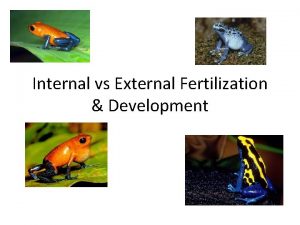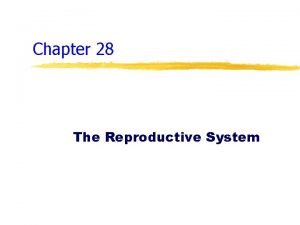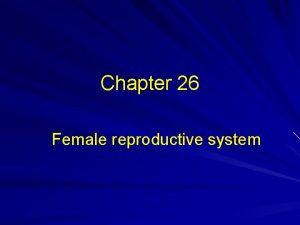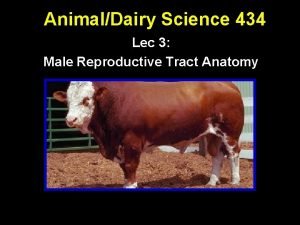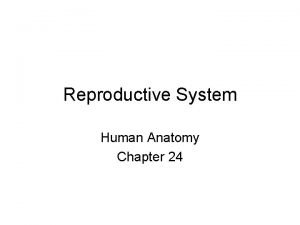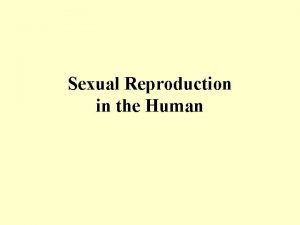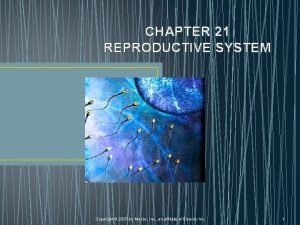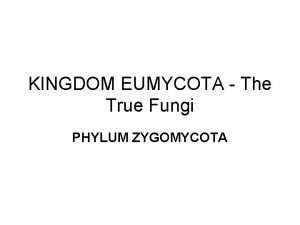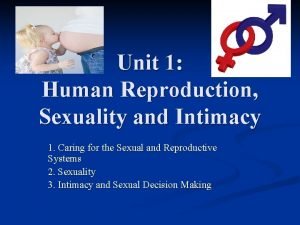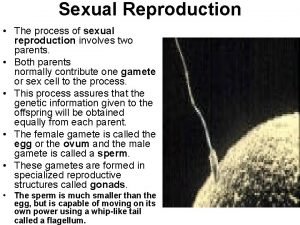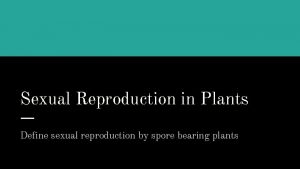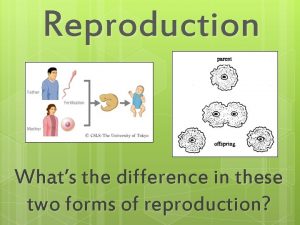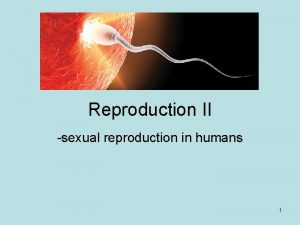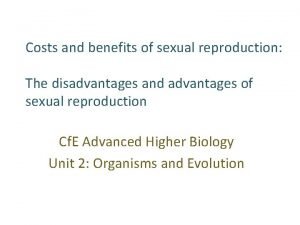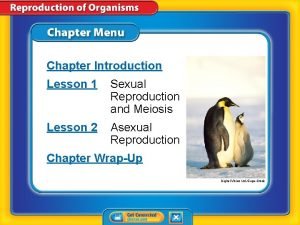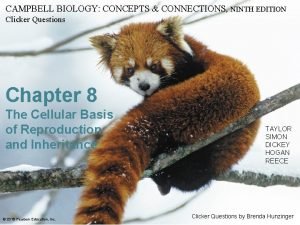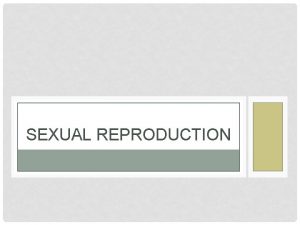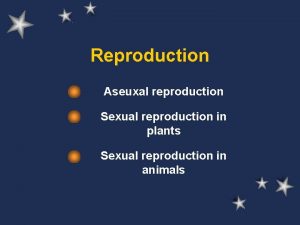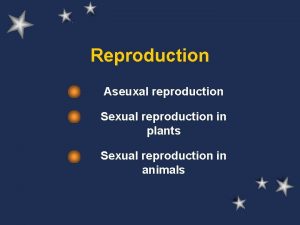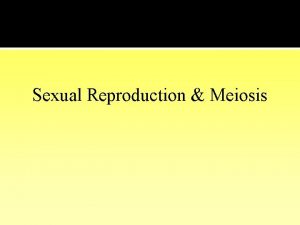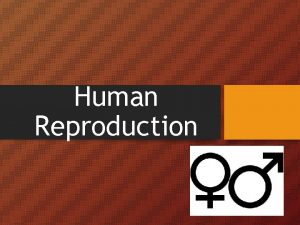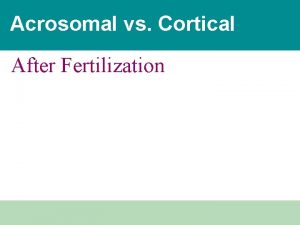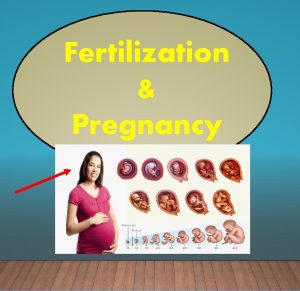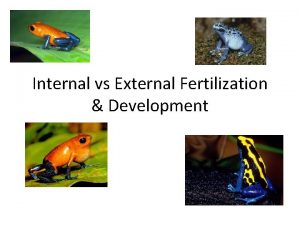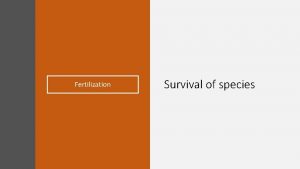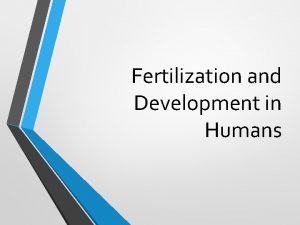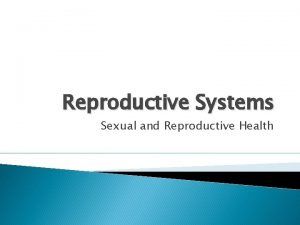Fertilization Sexual Reproduction Review questions Fertilization Reproductive organs



























- Slides: 27

Fertilization & Sexual Reproduction • Review questions • Fertilization • Reproductive organs • Meiosis (brief) • Genetic variation

In asexual reproduction, are the offspring different or the same as the parent? Answer: SAME! They are clones and genetically identical.

Which type of asexual reproduction is shown? Answer: Budding

Which type of sexual reproduction is illustrated below? Answer: External fertilization

Which type of sexual reproduction is illustrated below? Answer: Binary Fission

Which stage of MITOSIS is this? i A) Interphase B) Telophase C) Anaphase D) Metaphase Answer: ANAPHASE

Which stage of MITOSIS is this? i A) Interphase B) Telophase C) Anaphase D) Metaphase Answer: METAPHASE

The cell spends most (90%) of its time in which phase of the cell cycle? A) Interphase B) Telophase C) Anaphase D) Metaphase Answer: INTERPHASE

Which part of the cell cycle involves the cytoplasm pinching in half to form 2 new cells? A) Interphase B) Metaphase C) Anaphase D) Cytokinesis Answer: CYTOKINESIS

What is the correct order of the cell cycle? (3) Interphase (2) Prophase (5) Metaphase (1) Anaphase (4) Telophase *Cytokinesis isn’t shown

What is A called on the chromosome below? Centromere This is where the spindle fibers attach and the sister chromatids (B) separate.

Do all the cells on your body contain the same DNA (genetic information)? Yes/No? YES!!! You started off as just ONE cell that went through many stages of mitosis. All of your cells have the SAME DNA.

So how exactly did you start off as just one cell? ? Sexual Reproduction Fertilization = union of a sperm and egg

SEXUAL REPRODUCTION. = reproduction in which genetic information is contributed by 2 parents • Most animals have separate male and female sexes. • Male produces sperm • Female produces eggs

Animal Reproductive Organs Animals often have gonads, organs that produce eggs or sperm. Testes (male) produce sperm. Ovaries (female) produce eggs. 1 egg = 1 cell 1 sperm = 1 cell

Plant Reproductive Organs Plants that have flowers have their reproductive parts in the flower. The sperm is contained in the pollen, while the egg is contained in the ovary, deep within the flower.

The sperm can reach the egg 2 different ways in plants. 1) Self-pollination: the egg is fertilized by the pollen of the same flower. 2) Cross-pollination: sperm from the pollen of one flower fertilizes the egg of another flower on another plant combination of new traits!

Gametes = sex cells, such as a sperm or egg • Half the amount of genetic information as a regular body cell. • If a regular human body cell has 46 chromosomes, how many does a sperm cell have? A human sperm cell has 23 chromosomes.

Gametes are produced by a special type of cell division called MEIOSIS.

ZYGOTE When a sperm and egg meet during fertilization, a zygote is formed, the first cell of a new organism. • Combines the parents genetic information • Genetically unique

The zygote will then divide by mitosis and grow into the embryo.

So why are there so many different types of reproduction? There advantages and disadvantages to each type! Asexual Reproduction Advantages 1) Don’t have to find a mate 2) Very quick 3) Produces a lot of offspring if the conditions are right 4) Offspring have the same genetics

Asexual Reproduction Disadvantage Offspring have the same genetics!! = same DNA and mix of traits as the parent. WHY IS THIS BAD? 1) If the parent has a gene that causes a particular disease, the offspring will also have the gene that causes that disease. Also, offspring have less of a chance of survival and adaptability if the environment changes.

Sexual Reproduction Advantage = GENETIC VARIATION IN OFFSPRING! Offspring from sexual reproduction are a combination of their parents (they have traits from both!) More diversity (differences) in the species means that they are better able to adapt to changes in the environment!

Sexual Reproduction Advantage = GENETIC VARIATION IN OFFSPRING! Genetic variation also decreases the likelihood of inheriting bad traits. Diseases, disorders, intolerance to certain conditions

Sexual Reproduction Disadvantage 1) Have to find a mate More time spent finding a mate = more time for predators to find you and less time for other things (finding food, seeking shelter) 2) One mate may not be as good as another Have to select the appropriate mate = time + effort

Sexual Reproduction Advantage = GENETIC VARIATION IN OFFSPRING! Genetic diversity also reduces the likelihood of inheriting “bad” traits. *Disorders & Diseases *Intolerance to certain conditions Genetic Variation Video
 Sexual reproduction vs asexual reproduction venn diagram
Sexual reproduction vs asexual reproduction venn diagram Asexualk
Asexualk Sexual and asexual reproduction in animals venn diagram
Sexual and asexual reproduction in animals venn diagram External fertilization
External fertilization Uterus perimetrium
Uterus perimetrium Female reproductive organs sagittal section
Female reproductive organs sagittal section Reproductive organs of the bull
Reproductive organs of the bull Mesovariun
Mesovariun Rabbit reproductive system female
Rabbit reproductive system female Sperm duct
Sperm duct Parts of and functions of female reproductive system
Parts of and functions of female reproductive system The female anatomy
The female anatomy Chapter 21 reproductive system
Chapter 21 reproductive system Zygomycota examples
Zygomycota examples Fungi
Fungi Sexual reproduction in human
Sexual reproduction in human Sexual reproduction
Sexual reproduction A sexual reproduction involves
A sexual reproduction involves Define sexual reproduction
Define sexual reproduction Section 1 meiosis
Section 1 meiosis Whats a sexual reproduction
Whats a sexual reproduction Sexual reproduction in humans
Sexual reproduction in humans Pedigree miscarriage symbol
Pedigree miscarriage symbol Parthenogenesis asexual reproduction
Parthenogenesis asexual reproduction Reproduction of organisms
Reproduction of organisms Sexual reproduction and genetics section 1 meiosis
Sexual reproduction and genetics section 1 meiosis Mitosis sexual reproduction
Mitosis sexual reproduction Biology
Biology



